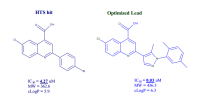Our activities and skills cover all main aspects in computational and theoretical chemistry.
In silico Chemistry Consulting
Having chemistry related problem or question? If you have a chemistry related problem or task, it is most likely that it can be solved or at least assisted with in silico chemistry. We will find an optimal approach fitting your particular needs and help you choose between alternatives.
Computational Toxicology
Below, please see the list of developed QSAR and ANN models, which are available for immediate prediction. All these models are also peer-reviewed and published in JRC QMRF Inventory.
Fragment and Ligand based Molecular Design
We analyse all possible combinations of molecular fragments and provide the structural candidates that are expected to carry desired predetermined properties.
High Level Computational Studies of Reaction Mechanisms
Too tough? Not really! Please see our research topics.
Virtual Library Screening
Planning an experimental assay? Designing or expanding a dataset? Looking for similar structures to your hits? How smart can it be done? Comprehensive descriptor and fingerprint based screening of chemical libraries for selecting subsets for experimental screening and analysis of results. The subsets are chosen based on predefined requirements that are evaluated in silico (solubility, logP, toxicities, etc). Sample study: Icosagen AS (Estonia) has developed a cell assay to measure the inhibition of HPV (Human Papillomavirus) replication. Their goal was to find novel potential inhibitors as fast and low-cost as possible. After testing the start-set of ~1500 chemicals they asked UT CCG to build a novel chemical library for further measurements. We used our virtual screening technologies and built a library of 300 untested chemicals. After experimental testing 3 chemicals out of 300 were selectively active to inhibit the initial stage of HPV replication in micromolar level.
Development of Computational Models for prediction of Properties and Biological Activities
What will be the properties/activity of such and such compounds, should we make them? Can we predict the properties beforehand?
Computer Aided Drug Design
We have tools and know-how to participate in drug design projects as a partner in fields of computational design and engineering. We do scaffold based hit and lead optimizations, early screening of possible side effects and fine tuning of the small molecule candidates.
№1
Case Study 1
I have a cell assay for determination of inhibition activities and now I would like to get a meaningful chemical library for further testing and hit expansion. How to optimize my expenses and get the best possible chemical library for further testing?
Steps taken (i) at glance:
- Quantitative characterization of existent set of active chemicals;
- Preliminary modeling and trend analysis for structure vs. activity;
- 3D descriptor based library screen to find additional set of similar and potentially active set of chemicals
- Fine tuning (hit-to-lead opt.) of chemical structures: trend analysis of structural fragments vs. activity
- In silico design of novel potentially active molecules based on combination of fragments and extrapolation of molecular characteristics and experimental data.
Steps taken (ii) in detail:
| MODULE | Activity | Outcome |
| PRELIMINARY QSAR MODEL | Optimization of chemical structures, 2D and 3D descriptor calculation | Descriptor/activity matrix |
| Selection of algorithm, training and test set, QSAR modeling, validation | Statistically valid QSAR model for preliminary prediction activities for novel chemicals | |
| IN SILICO 2D FINGERPRINT VIRTUAL SCREENING | Assessment of available data. Ranking and selection of compounds by activity vs similarity analysis, assigning weights for fingerprint screening | Selected active compounds for further scaffold expansion |
| 2D fingerprint screening over a diverse set of (appr.) 400 000 structures | Selection of 200 compounds for further assessment | |
| ADVANCED 3D FINGERPRINT VIRTUAL SCREENING | Analysis of the selected 200 compounds, identification of unique structural features, conversion to 3D, preliminary geometry optimization (FF level) | Description of the 200 hits from 2D screen |
| Structure optimization and calculation of 3D descriptors, including constitutional, toplogical, quantum-chemical, etc | Descriptor/structure matrix for 100 compounds | |
| SELECTION OF HIT COMPOUNDS | Detailed screening and selection of a set of top promising similar compounds based on 2D fingerprints (50) and 3D descriptors (50) | Selection of 100 compounds (50+50) for in vitro assay |
| HIT-TO-LEAD OPTIMIZATION | Analysis of activity trend over the structural fragments | Potential leads |
| DESIGN OF NOVEL COMPOUNDS BY COMBINATION OF FRAGMENTS | Definition of training set structures as combination of fragments; calculation and screening of all possible fragment combinations; selection of best potentially active compounds | Set of novodesigned molecules with potential biological activity |
№2
